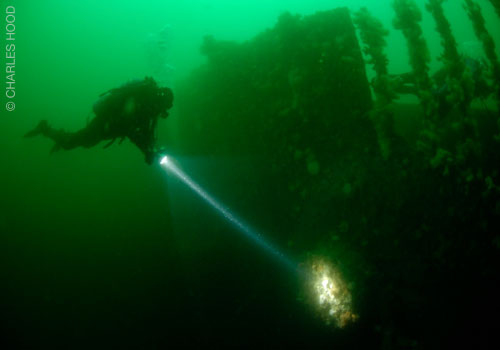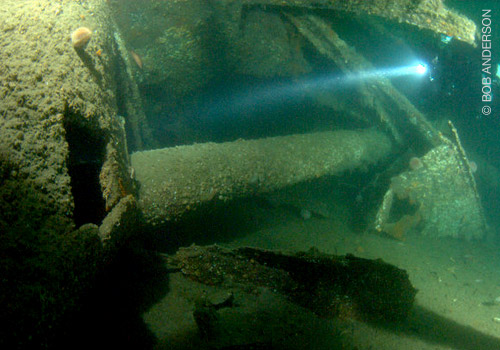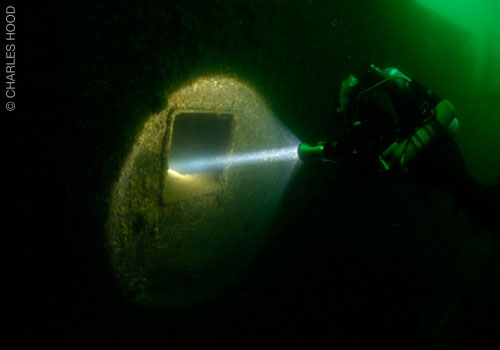Diving the SMS Brummer wreck
The Brummer is a firm favourite amongst divers of Scapa Flow. This mine-laying cruiser rests on her starboard side on the flat sandy seabed at 36 metres. The wreck rises up to 22 metres at its shallowest point. Enjoyable and involved 35 metre dives can be achieved on the SMS Brummer without the need for any overly technical commitment.
The entire wreck can be circumnavigated in one dive, but routes that were once easy to follow have become more intricate in recent years due to a number of collapses. With an experienced guide, or a good understanding of how the ship is collapsing, the SMS Brummer still has much to reveal. Much of the ship's arsenal remains and the bridge is one of the iconic sights of Scapa Flow. Such features help to emphasise the scale and beauty of this class of historic warship.
Bow section
The bow of the SMS Brummer has a curved and graceful stem; it was engineered for speed. The bow points roughly to the north and its tip rests on the seabed. Both the port and starboard anchor chains run across the deck and around the two capstans before disappearing down their spurling pipes and into the chain lockers.
Further aft the top deck is peeling away from the hull and now curves over the superstructure of the ship. Four 5.9 inch guns would have been mounted along the centre line of the SMS Brummer. The forward gun now rests on the seabed, still pointing toward the bow.
Armoured Control Tower and bridge
The Armoured Control Tower is also peeling away from the main wreck structure and rests at an angle of 45 degrees. The door to the control tower lies open but the contents have long since been removed.
The collapse of the control tower has opened up the deck above and the exposed areas of deck below can now be accessed relatively easily. The internal access hatches of the ship are on view; they help to illustrate a bygone era of the ship when the SMS Brummer's crew were busy at work and moving about between the armoured command points.
The bridge of the SMS Brummer can be distinguished in a single glance and it is one of the iconic sights of Scapa Flow. The bridges on many of the other wrecks in Scapa are more reminiscent of bare scaffolding structures but here the bridge remains in good condition. It was constructed of brass so as not to interfere with the magnetic compasses.
A few human touches remain inside the bridge including a compartmentalised storage box - perhaps used to store the array of naval flags used for signalling. Intricate features such as this provide a connection across the span of time and make many divers feel more involved in the wreck.
Just to the rear of the bridge is the mast. It supports two searchlight platforms where two shut-off irises from the ship's searchlights remain. They resemble giant aperture leaves from a camera. The corroded remains of the searchlight body can be seen lying around.
Boiler rooms
The first of the SMS Brummer’s three funnels was situated directly behind the bridge. All three were made of thin steel and thus they corroded quickly after the ship was scuttled. Although the funnels are gone, the impression of the first can still be seen on the seabed today. The second of the four 5.9 inch guns that lay along the ship's centre line has fallen away from deck here and now sits on the seabed pointing aft.
Blasting around the engine room during the salvaging operations weakened this area of the wreck and the port side of the hull is now starting to fall inwards between the top two decks.
Stern section
The stern mast protruding from the wreck and lying across the seabed marks the start of the stern section. This area has remained largely undamaged from the salvaging operations, but much of the top deck and superstructure are falling away from the ship. The final two 5.9 inch guns from the centre line of the ship are easy to miss here as they lie near to the overhanging deck plates.
The kedge anchor remains housed and marks the aft-most point of the SMS Brummer. The hull has opened up here; the steering room and steering engine can be quite easily seen by divers progressing past the multitude of wires and heating coils that still hang from the wreckage.
The steering engine can also be accessed by swimming down the hull and over the rudder toward the keel. Remember the SMS Brummer is lying at a 90 degree angle on her starboard side. The supporting A-frame remains can be seen overhead at this point. Some of the hull plates have rotted away here and have exposed the steering engine below.
Engine room
The salvage teams seem to have followed their usual routine on the SMS Brummer – blasting away the top side of the hull here in order to remove the valuable non-ferrous components in the engine rooms. Despite their efforts some massive components have been left, including gear wheels, turbines, valves and pipes. A diver can be made to feel quite small when diving alongside engineering components on this scale.
Destructive forces
Most of the present deterioration on the SMS Brummer is due to the effects of immersion and the fact that the ship is lying on her side. There have been a number of notable and visible changes in recent years and these tend to follow the same theme: destructive forces leading to the top deck peeling away from the hull, especially in areas where there is additional weighting such as around the Armoured Control Tower.
When the dynamics of these destructive forces are understood the wreck becomes much easier to navigate. New divers on the SMS Brummer will get the most out of their dives by using an experienced dive guide.
Wrecks Protected Status
In recognition of their historical and cultural importance, the wrecks of the SMS Cöln, Dresden, Brummer, Karlsruhe, Kronprinz Wilhelm, König and Markgraf have been protected as scheduled monuments. Divers are welcome to enjoy and respect these wrecks but removal of artefacts from them is illegal. For more information, please visit the: MCA Website
















